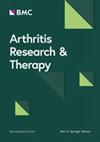Disease remission and sustained remission after etanercept biosimilar or originator initiation in rheumatoid arthritis: an interim real-world analysis
IF 4.6
2区 医学
Q1 Medicine
引用次数: 0
Abstract
We compared time to first remission and prevalence of sustained remission in participants with rheumatoid arthritis (RA) initiating etanercept biosimilar (ETA-B) or originator (ETA-O). We studied etanercept-naive participants with RA from four Canadian prospective cohorts who initiated ETA-B or ETA-O (Jan/2015-May/2022). Disease remission was determined using disease activity scales. Sustained remission was defined as at least two consecutive visits in remission within the first 12 months of follow-up. Multivariate Cox regression was used to compare the probability of achieving remission between ETA-B and ETA-O, and multivariate logistic regression was used to assess sustained remission. We studied 150 participants with RA (ETA-B: 65.3%). Among 125 participants not in remission at baseline, the median time to first remission was 8.7 months (95% confidence intervals [CI] 5.2–12.1) in the ETA-B group and 14.5 months (95% CI 4.7–18.6) in the ETA-O group. Time to first remission was similar between the groups (log-rank test: P-value = 0.51). Multivariate Cox regression showed no clear difference in first remission between ETA-B and ETA-O (adjusted hazard ratio 1.52, 95% CI 0.68–3.39). Among 125 participants with at least 12 months of follow-up, the prevalence of sustained remission was 19.5% for ETA-B and 21.0% for ETA-O. In multivariate analysis, we did not detect a significant difference in sustained remission between ETA-B and ETA-O (adjusted odds ratio 1.14, 95% CI 0.29–4.87). We did not detect clear differences in first remission and sustained remission between participants with RA initiating ETA-B or ETA-O. Not applicable.类风湿关节炎依那西普生物类似药或原药起始治疗后疾病缓解和持续缓解:一项中期现实世界分析
我们比较了类风湿关节炎(RA)患者服用依那西普生物类似药(ETA-B)或原药(ETA-O)的首次缓解时间和持续缓解的患病率。我们研究了来自四个加拿大前瞻性队列的未使用依那西普的RA患者,他们开始了ETA-B或ETA-O(2015年1月/2015年5月/2022年)。使用疾病活动量表确定疾病缓解。持续缓解被定义为在前12个月的随访中至少连续两次缓解。采用多因素Cox回归比较ETA-B和ETA-O达到缓解的概率,采用多因素logistic回归评估持续缓解。我们研究了150名RA患者(ETA-B: 65.3%)。在125名基线时未缓解的患者中,ETA-B组首次缓解的中位时间为8.7个月(95%可信区间[CI] 5.2-12.1), ETA-O组为14.5个月(95% CI 4.7-18.6)。两组间首次缓解的时间相似(log-rank检验:p值= 0.51)。多因素Cox回归显示ETA-B和ETA-O的首次缓解无明显差异(校正风险比1.52,95% CI 0.68-3.39)。在随访至少12个月的125名参与者中,ETA-B组持续缓解的患病率为19.5%,ETA-O组为21.0%。在多变量分析中,我们没有发现ETA-B和ETA-O之间持续缓解的显著差异(校正优势比1.14,95% CI 0.29-4.87)。我们没有发现RA患者开始ETA-B或ETA-O治疗时首次缓解和持续缓解的明显差异。不适用。
本文章由计算机程序翻译,如有差异,请以英文原文为准。
求助全文
约1分钟内获得全文
求助全文
来源期刊

Arthritis Research & Therapy
RHEUMATOLOGY-
CiteScore
8.60
自引率
2.00%
发文量
261
审稿时长
14 weeks
期刊介绍:
Established in 1999, Arthritis Research and Therapy is an international, open access, peer-reviewed journal, publishing original articles in the area of musculoskeletal research and therapy as well as, reviews, commentaries and reports. A major focus of the journal is on the immunologic processes leading to inflammation, damage and repair as they relate to autoimmune rheumatic and musculoskeletal conditions, and which inform the translation of this knowledge into advances in clinical care. Original basic, translational and clinical research is considered for publication along with results of early and late phase therapeutic trials, especially as they pertain to the underpinning science that informs clinical observations in interventional studies.
 求助内容:
求助内容: 应助结果提醒方式:
应助结果提醒方式:


